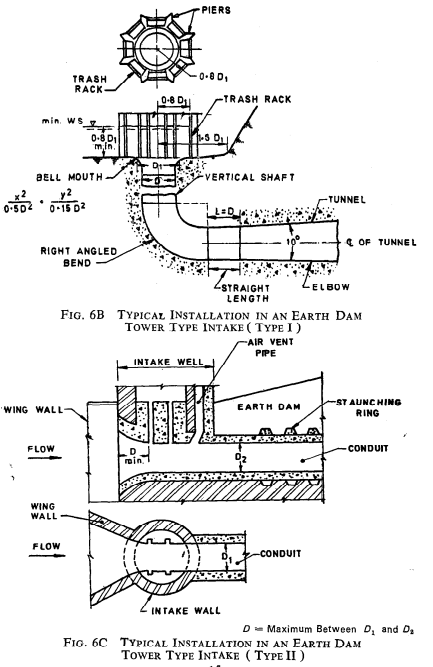INTRODUCTION
The intake structure is a hydraulic structure. Which is used to divert the water from a source (like a reservoir, river) into a conduit (like a canal, tunnel, or pipe). It also supports auxiliary appurtenance (Such as trash rack, fish screens, and bypass devices) and it may include provision for installation of the bulkhead gates or stop-log gates closure devices.
TYPE OF POWER INTAKE STRUCTURE
The Position and location of intake would generally depend upon the type of development and may be classified under:
A) Run-Of-the river type Intake
B) Reservoir-type intake
- Depending on the function, an intake structure may be either submerged or extended in the form of a tower above the maximum reservoir water surface (Fig. 6B)
- An operating platform is needed to remove trash, maintain and clean fish screens, or install stoplog gates.
- Depending on intake requirements, the entrance may be placed vertically, inclined, or horizontally.
- Conduit entrances should be rounded or bell-mouthed to reduce hydraulic entrance losses.
- The necessity for a trash rack Structure depends on the size of the Intakes structure, the type of control device used, the nature of the trash burden in the reservoir, the use of the water, the need for excluding small trash from the outflow, and other factors.
The selection of power Intake structures should be based on several factors:
- Operation (The Reservoir head under which it must operate)
- Discharge (It Must be handled)
- The Frequency of reservoir drawdown, trash rack condition in the reservoir (need for cleaning of trash rack)
- Ice Condition and wave action (From the stability point of view)
- Depending on its function, An Intake structure may be either submerged or extended in the form of a tower.
IS Code Used For Power Intake Structures
- IS: 11625 1986: Criteria for Hydraulic Design of Penstocks
- IS: 4880 1976: Code of practice for design of tunnels conveying water
- IS: 11388:2012: Recommendations for design of trash racks for intakes
- CBIP manuals
- USBR Manual for Small Dams









.png)
.png)

0 Comments